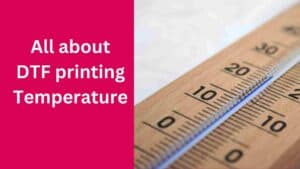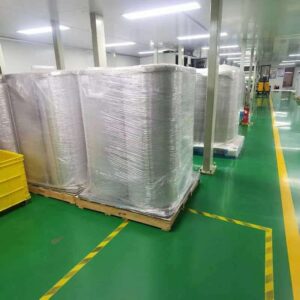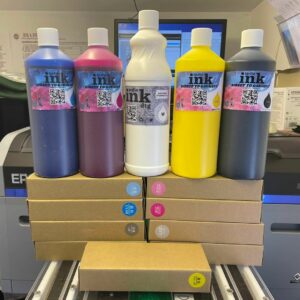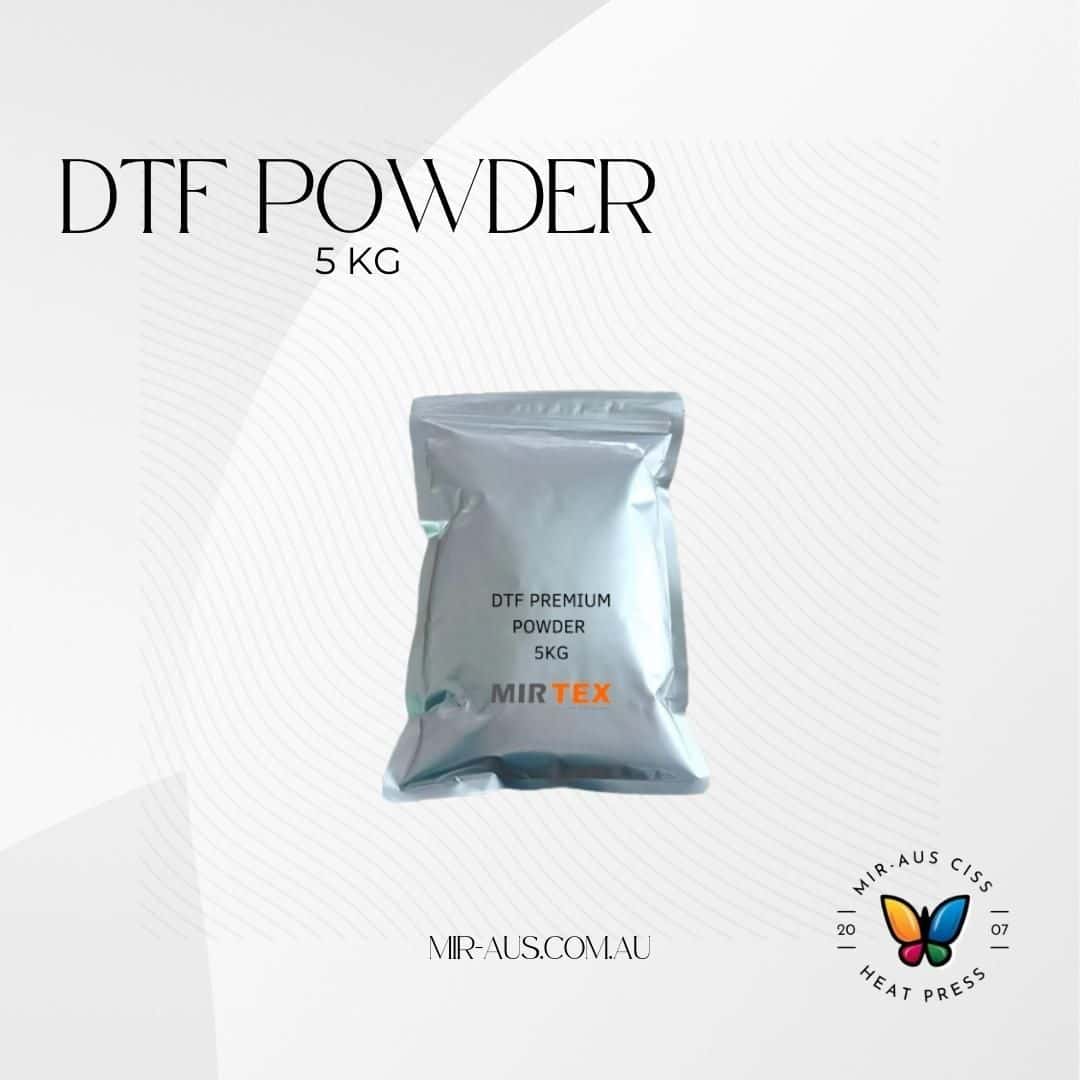With DTF printing, obtaining high-quality prints can be difficult. The DTF printing temperature is one of the important elements that greatly influences print quality. Inaccurate printing temperatures cause image transfer, color bleeding, and poor print quality. When a printmaker spends hours making a design only to have it ruined by the wrong temperature settings, it can be very frustrating.
This may also result in the waste of resources, time, and materials. Understanding temperature for DTF and how to manage it is crucial for best print quality. This blog article discusses DTF printing temperature, the recommended temperature range, and the necessity of maintaining correct temperature while printing. We will also go through typical temperature-related problems with DTF printing and how to fix them. Using this information, printmakers can improve print quality and lower the likelihood of resource and material waste.

Factors affecting DTF printing temperature
Type of transfer film used
One of the key component that affects the temperature of DTF printing is the kind of transfer film that we use. Transfer films are constructed of PET or PVC, which melt at various temperatures. PVC films normally have a melting temperature of 170-180°C, while PET films typically have a melting point of 140-150°C.
Because of this, it is essential to choose the proper transfer film for the kind of printer and ink you are using and to modify the printing temperature appropriately. Utilizing a transfer film with a melting point lower than the ink’s suggested temperature might destroy the film and cause partial transfer.

The ideal printing temperature is influenced by both the kind of transfer film and the thickness of the film. Thicker films need higher temperatures for full ink transfer, whereas thinner films need lower temperatures to avoid transfer film damage.
Type of printer used
Another aspect that impacts DTF printing temperature is the kind of printer we use. Technology and components determine printer capabilities and printing temperature ranges.
For instance, piezoelectric print heads allow printers to print at lower temperatures than thermal print heads. Also, in order to maintain a constant temperature during the printing process, printers with a bigger print bed need more heat.
So, understanding the printer’s capabilities and adjusting the printing temperature are crucial. Failing to do so may result in a damaged transfer film, an incomplete transfer, or even harm to the printer.
Type of ink used
Next crucial element that impacts DTF temperature is the kind of ink employed. Printing inks at the wrong temperature might harm the transfer film or cause partial transfer.

For instance, printing temperatures for water-based inks are usually lower than those for solvent-based inks. Water-based inks evaporate at high temperatures, making transfer partial. On the other hand, solvent-based inks need higher temperatures to allow for good melting and transfer.
As a result, it’s critical to choose the proper ink type and modify the printing temperature in accordance with the transfer film. Failing to do so may lead to subpar printing and wastage of resources.
Humidity and temperature of the printing environment
One more important aspect that affects the temperature for DTF printing is the environment’s humidity and temperature. Transfer film may absorb moisture in high humidity, resulting in partial transfers or poor print quality. On the other side, low humidity levels might result in the transfer film becoming brittle and cracking, damaging the transfer film and lowering the quality of the print.
In a similar manner, printing temperature is influenced by the environment’s temperature. If the printing environment is too cold, it may cause incomplete transfers or poor print quality, while too hot can damage the transfer film and over-melt it.
As a result, it’s crucial to manage the humidity and temperature of the printing environment in order to maintain the ideal printing temperature. You can achieve it by using a dehumidifier or humidifier, as well as by installing suitable heating or cooling systems. To minimize moisture absorption and maintain appropriate temperature ranges, transfer film and ink should be maintained in a controlled atmosphere.
What is the best temperature for DTF printing?
DTF printing temperature depends on transfer film, printer, ink, and atmosphere. The desired temperature is one that permits full ink transfer while causing the least amount of harm to the transfer film.
DTF printing works best at 150-170°C, however materials may affect this. Start at the low end of the temperature range and progressively raise until you get the desired results. To protect the transfer film and printer, do not exceed the prescribed temperature range.
Test prints are essential to verify the right temperature. Test prints can determine the optimal temperature for transfer films, inks, and printers and detect any temperature-related concerns.
Factors to consider when determining the optimal temperature
DTF printing temperature depends on multiple variables including:
- Transfer film: PET or PVC might affect the ideal temperature range. Choose the right film for the ink and printer based on melting points.
- Type of printer: The appropriate temperature range depends on the printer’s print head technology and print bed size. Different printers may need different temperatures for effective transfer.
- Type of ink: The ideal temperature range may vary depending on the kind of ink you use, such as solvent- or water-based ink. As different inks have various melting points, it is crucial to choose the right ink for the particular transfer film in question.
- Temperature and humidity in the printing environment: The ideal temperature range is impacted by the humidity and temperature in the printing environment. To optimize printing, control the humidity and temperature.
- Thickness of transfer film: The ideal temperature range depends on transfer film thickness. Thicker films need higher temperatures to transfer completely, whereas thinner films need lower temperatures to avoid damage.
- Substrate material: The ideal temperature range depends on the substrate material. Different materials may require different temperatures to achieve optimal transfer.
Importance of maintaining proper temperature during DTF printing
Effects of temperature on print quality

For DTF printing to produce high-quality prints and save waste, we need to maintain the correct temperature. Temperature has a significant impact on the ink transfer process and the final print quality in a number of different ways.
The ink may not melt fully if the temperature is too low, resulting in partial transfer and poor print quality. In contrast, if the temperature is too high, the transfer film can overheat and destroy itself, which would result in subpar print quality.
Furthermore, temperature has an impact on how well the ink adheres to the substrate. The ink may not attach properly to the substrate if the temperature is too low, leading to poor adhesion and a lower-quality print. Conversely, if the temperature is too high, the ink may attach too tightly, making it difficult to remove the transfer film and damaging the prints.
Temperature also affects print durability. The print’s durability and longevity may suffer if the temperature is too low. Conversely, if the temperature is too high, the ink may adhere too firmly, making it impossible to remove the transfer film without destroying the print.
Effects of temperature on transfer film durability
Temperature may significantly affect how long the transfer film used in DTF printing lasts. The transfer film may brittle and split if the temperature is too high, damaging the film and lowering the quality of the print. Nevertheless, if the temperature is too low, the ink may not transfer entirely, reducing print durability.
Inconsistent temperature may also cause ink to adhere inconsistently to the substrate and transfer film, resulting in a lower-quality DTF prints with cracking issues and less durability.
We can maintain the transfer film’s flexibility, strength, and adherence by correct temperature management during printing. This ensures the print’s durability.
To ensure transfer film longevity, monitor and adjust printing temperature. A temperature-controlled printing environment and frequent printing process testing may accomplish this.
Ways to ensure proper temperature maintenance during DTF printing
There are numerous approaches to maintain temperature during DTF printing:
- Use a temperature-controlled environment for printing: It is crucial to utilise a temperature-controlled environment for printing in order to maintain a constant temperature throughout the operation. A printing room with temperature control or heating or cooling systems may do this.
- Monitor the temperature: Using a thermometer or temperature sensor, it’s crucial to keep track of the temperature when printing. This can identify temperature changes that may affect the transfer film, ink, or substrate.
- Use a constant printing temperature appropriate for the transfer film, ink, and substrate for consistent, high-quality prints.
- Conduct regular temperature checks: Maintain appropriate printing temperatures with frequent temperature monitoring. For consistency, take temperature measurements before, during, and after printing.
- Adjust temperature as needed: In order to preserve the best possible transfer film, ink, and substrate qualities, you need to adjust the temperature as necessary if you observe any temperature variations throughout the printing process.
- Perform test prints: Test prints are a good way to find out if there are any temperature-related problems that can affect the transfer film, ink, or substrate. This can determine the best temperature range and any necessary modifications for high-quality prints.
Troubleshooting temperature-related issues in DTF printing
DTF printing may have temperature-related difficulties, which can be addressed to generate high-quality prints. These are some typical temperature-related DTF printing problems and the troubleshooting techniques to fix them:
- Incomplete ink transfer: A temperature that is too low may be the cause of an incomplete ink transfer. The ink melts entirely when we raise the temperature.
- Overmelted transfer film: If the transfer film overmelts, the cause may be an excessively high temperature. It is possible to prevent the transfer film from overmelting and damage by lowering the temperature.
- Poor ink adherence to substrate: A temperature that is too low may be the cause of poor ink adhesion to the substrate. Increased warming helps ink stick to the substrate.
- Ink that is excessively adherent to the substrate: A temperature that is too high may be the cause of the ink’s excessive adhesion to the substrate. The ink sticks better at lower temperatures, making it simpler to remove the transfer film without ruining the print.
- Transfer film that is brittle or cracked: If the transfer film is brittle or cracks, it may be because the temperature is too high. The transfer film’s flexibility and strength may be maintained by lowering the temperature.
To get best print quality, examine the printing process and adjust the temperature often. By keeping an eye on the temperature, checking it regularly, and changing it as needed, you can fix problems that are caused by the temperature and get high-quality prints from DTF printing.
What is DTF curing temperature?
Screen and DTG printing need curing, however DTF (Direct-to-Film) printing does not. When the DTF process transfers the print to the substrate, the ink is air-dried or heat-pressed at 160-180°C (320-356°F) for a brief time (usually less than a minute).
Nevertheless, ink and substrate may affect cure temperature and time. For best print adherence and longevity, follow the manufacturer’s ink curing instructions.
What temperature should DTF be on polyester?
185-200°C (365-392°F) is the required temperature range for DTF printing on polyester. This corresponds to temperatures equivalent to 365–380 degrees Fahrenheit. A temperature range of 280-300°F may work for certain DTF printing applications, but it may not be adequate for good adherence and endurance of the print on polyester, resulting in lower-quality prints that may not resist washing or wear.
The thickness and composition of the polyester material and the printing environment’s humidity and temperature may also affect the temperature range. Test prints at different temperatures can help figure out the best temperature range for printing on polyester that looks good.
What temperature does DTF powder melt?

The normal melting point for DTF (Direct-to-Film) powder is between 110 and 125°C (230 and 260°F). This melting temperature range helps the powder stick to the printed ink and produce a smooth, uniform surface for the transfer film during printing.
Ideal DTF Heat Press Settings
DTF (Direct-to-Film) heat press settings depend on the transfer film, ink, and substrate. Here are some basic DTF heat press settings:
- Temperature: For DTF heat press settings, the optimum range is normally between 150 and 165 °C (302 and 329 °F). The actual temperature may vary based on the materials you are using, therefore it’s crucial to follow the manufacturer’s temperature guidelines.
- Pressure: The recommended pressure for DTF heat press settings is medium to high, often ranging from 3-5 kg/cm2 (43-71 psi). This may make sure that the ink transfers completely and that the transfer film sticks to the substrate securely.
- Time: The recommended time for DTF heat press settings is typically between 30-60 seconds.
Conclusion
In conclusion, DTF printing quality and durability depend on temperature. The optimum temperature range for DTF printing relies on a number of variables, including the kind of transfer film we use, the printer, ink, and substrate. Maintaining a steady and optimum temperature range during printing ensures excellent adhesion and print quality. We can optimize the DTF printing by following the manufacturer’s instructions and testing temperatures.

Ashley Wang is a skilled sales manager with knowledge in DTF printing. She presently works for ShenLan Digital, a reputable DTF printer maker. Ashley is the best person to offer advice on selecting the most suitable DTF printer because she has tested a lot of them. She launched DTFPrinterSchool to educate individuals and organisations about DTF printing technology, providing her expertise and observations on the most recent advancements in the sector. Ashley is an invaluable resource for businesses and individuals wishing to invest in DTF printing technology because of her expertise and experience in the industry.
